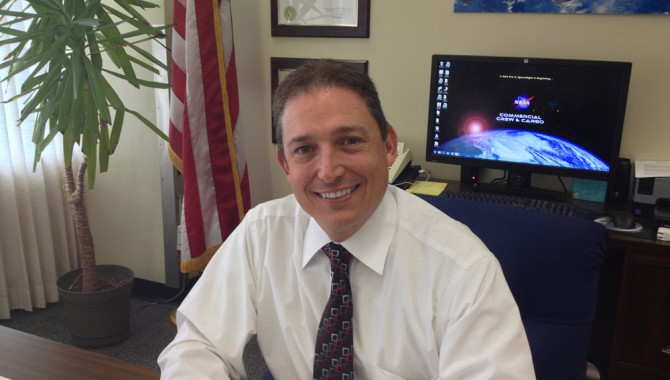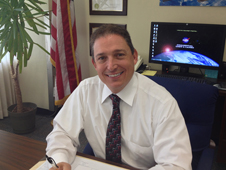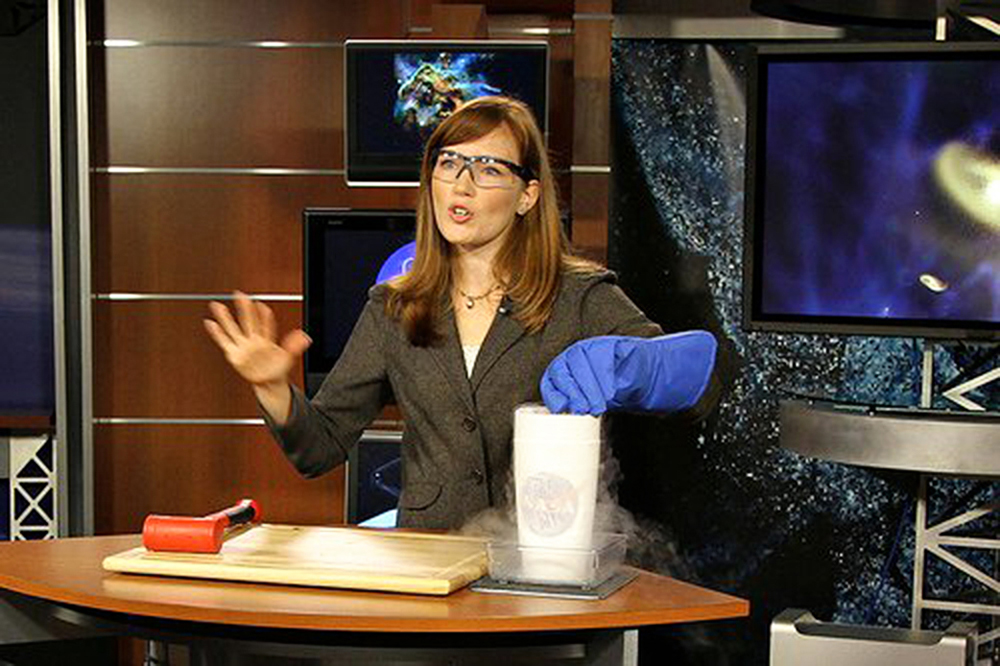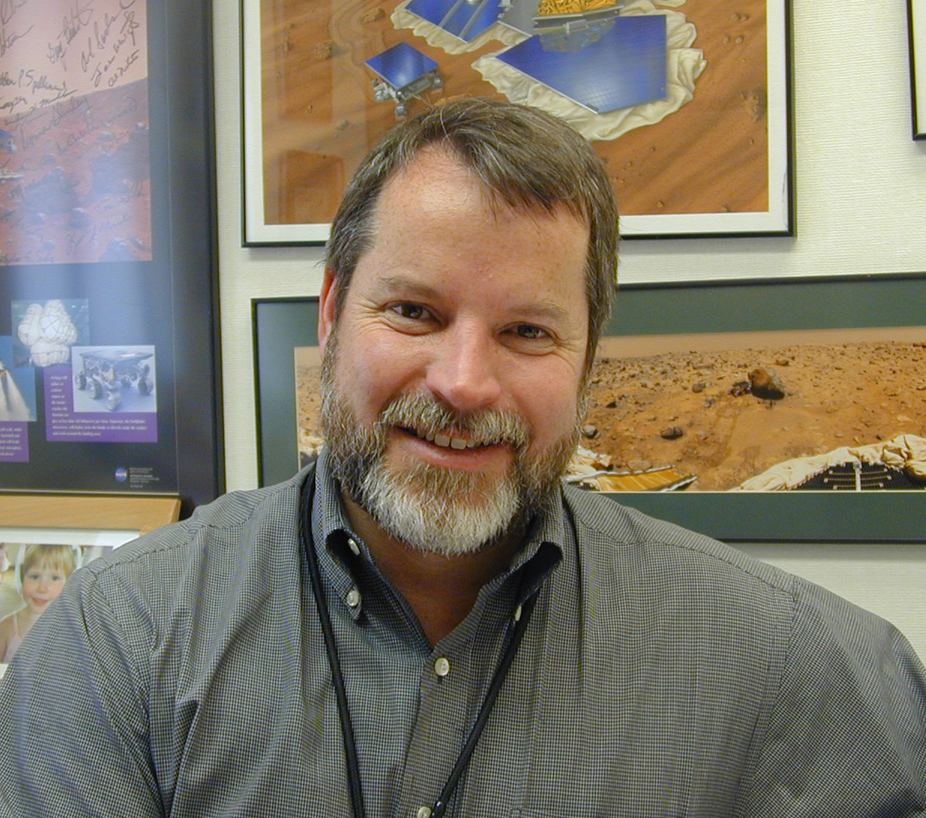
By Don Cohen
Originally a co-op student at Goddard Space Flight Center, Alan J. Lindenmoyer has worked on human spaceflight programs for more than thirty years. In 2005, he was appointed manager of the Commercial Crew and Cargo Program, which manages Commercial Orbital Transportation Services (COTS), at the Johnson Space Center.

Cohen: Why was the Commercial Orbital Transportation Services program created?
Lindenmoyer: The Commercial Crew and Cargo Program was established in late 2005 as part of the U.S. Space Exploration Policy to promote the commercial space industry. Shortly after Mike Griffin came on board as administrator, it was clear to him that we needed to provide significant opportunities for U.S. private industry to demonstrate capabilities that could possibly meet our needs. We have obligations to service the space station with cargo and crew resupply over its service life, but we were retiring the shuttle. We would have loved to have gone to a catalog and been able to order up cargo-delivery services to the station, but they didn’t yet exist in the U.S. The COTS challenge was to provide initial seed money and technical support to help industry develop those capabilities so that ultimately we could purchase them. We used our Space Act authority to enter into public-private partnerships, which we called Commercial Orbital Transportation Services, or COTS, agreements.
Cohen: To help them develop in a different way from the traditional NASA approach?
Lindenmoyer: We know very well how to define requirements, hire a prime contractor, and pay the full cost of developing a spaceflight capability. Our challenge was to take the experience, lessons learned, and the technologies we’ve developed over the last fifty years and make them available to industry to help generate this new capability. Instead of the traditional approach of writing requirements and hiring a contractor, we decided to become a lead investor and a consumer of services. We had to learn how to become an investor instead of a technical director, a partner providing financial and technical assistance. We wanted to do it not only to meet NASA needs but for a larger public purpose.
Cohen: How did you choose the industry partners?
Lindenmoyer: The first step was to put together program goals and objectives and the evaluation criteria. This wasn’t to be a handout; it wasn’t to be a grant. It was to be a competitive award of agreements with industry that would reduce the cost of access to low-Earth orbit, which is key to opening new markets and helping build a vibrant space-transportation industry. We would facilitate the demonstration of cargo and crew space-transportation capabilities with the goal of achieving safe, reliable, and cost-effective access to low-Earth orbit. We said we would focus on cargo demonstrations first and then would discuss the possibility of extending our agreements or establishing other agreements for crew transportation.
Cohen: Attracting non-NASA customers depends on reducing the cost.
Lindenmoyer: Absolutely.
Cohen: So what would allow these companies to reduce cost?
Lindenmoyer: We identified a range a capabilities of interest to NASA, not a firm set of requirements to meet. Companies could choose which capabilities to provide. Traditionally we write requirements, we direct their implementation, and companies build what we ask for. We wanted to provide flexibility for these companies to innovate and optimize their systems to the maximum extent possible to reduce cost. If the result was a capability that only the government could afford, that wasn’t going to meet our objectives.
Cohen: Was choosing the winning companies difficult?
Lindenmoyer: We competitively selected a portfolio of companies we had the highest level of confidence could achieve those capabilities. We went about it in a very rigorous way. Instead of scoring proposals the way we usually do, we had to find a new way to evaluate because companies weren’t all going to meet the same set of requirements. Everyone was planning to do something different. Some might propose developing pressurized cargo; some would talk about unpressurized carriers; some would talk about doing crew transportation; some would propose cargo return and others wouldn’t. We allowed companies to bid on any combination of these capabilities. We kept the requirements to a minimum. The only firm requirements we insisted on were with the interfaces to the space station. Obviously if companies elected to do a demonstration to the station, they had to meet the physical- and data-interface requirements and comply with our safety requirements. Once the vehicle enters the control zone of the space station, there is no compromising the level of safety. They weren’t required to go to the station, but if they elected to attempt to do that, we said we would make it available and help with the integration of their vehicle to the station. Those were the only firm requirements we had; everything else was goal related. We had a healthy competition. We wanted to level the playing field so that both emerging companies and established companies could compete equally and fairly.
Cohen: How did you go about evaluating those different proposals?
Lindenmoyer: We evaluated three elements of the proposals: the technical approach, the business plan, and the cost—not so much the relative cost of one proposal to the other, but our confidence in the ability of the organization to complete the demonstration effort within the proposed cost. This became another important characteristic of our program. We would not be paying the full cost of the demonstration. It was to be a shared-cost effort. If the company was confident that they could develop a capability that could be used for other customers, they should put skin in the game and share the cost risk with us. The business plan was very important. NASA is not accustomed to evaluating a company’s business plan, so we hired a venture-capitalist consultant to help us. He helped write a request for a business plan. We didn’t know how to ask for one, let alone evaluate one. Our consultant helped us ask for what we now know are the standard elements of any business plan: business strategy, market assessment, governance structure, management team, sources of financing, revenue, and projections of cash flow and expenses. We had to be educated to evaluate all that information because a company that didn’t have a viable business wasn’t going to help us no matter how good the technical accomplishments. We also wanted to build a portfolio of companies. Competition is a very important element of keeping cost and price down.
Cohen: And if more than one succeeded?
Lindenmoyer: If they succeeded, we wanted to be able to be the customer for multiple companies. Another thing we learned was that new ventures like this don’t all succeed. In highly complex ventures, maybe one out of ten gets all the way to the end. We knew it would be best to include as many as we could in our portfolio, knowing that they may not all make it. If we get at least one by the end, that would be good. Having multiple capabilities would even be better.
Cohen: How many companies were initially selected?
Lindenmoyer: We had approximately $500 million available over five years to invest in these companies. We picked two companies in 2006 to share the $500 million and kept just 3 percent—$15 million—for our program operations. We wanted to make sure that the majority of resources were in the hands of the companies. We picked two: Space Exploration Technologies (SpaceX) and Rocketplane Kistler (RpK).
Cohen: Has setting goals rather than establishing requirements encouraged innovation?
Lindenmoyer: It absolutely has, but we weren’t necessarily looking for new technologies. We shouldn’t expect companies to develop cutting-edge technology. It’s NASA’s job to do that. We wanted to share our technology and let industry operate and develop capabilities in new and effective ways. That’s what we saw with SpaceX. They have developed a new medium-class booster using standard liquid-fuel technology—kerosene and liquid oxygen. That technology was not new, but they were able to develop their engines, put together the first stage, second stage, and a capsule spacecraft in very cost-effective ways. That was the strategy of their company: to develop reliable low-cost access to space. It wasn’t a new technology, but it sure was a new way to do business.
Cohen: How did they keep costs down?
Lindenmoyer: They controlled costs by doing a majority of the design and development in house. That was the SpaceX innovation. Rocketplane Kistler’s concept was to develop a reusable launch system. They also were using liquid-fueled engines, but they wanted to have a fly-back booster that would land and be turned around and quickly reused. That was their innovation. We were planning to invest up to $207 million; their program required another $500 million at least. Their challenge was to raise that financing up front. Unfortunately, they weren’t able to get there. We knew that was a risk going into this partnership, so we made a financial milestone one of our progress gates up front, stating they needed to raise at least one round of financing before we continued. They chose to combine all three rounds of financing and raise $500 million in one round. We were very patient with RpK and gave them every opportunity to succeed but we recognized that it just wasn’t going to happen. The market took a downturn and financing dried up for that level of investment. Within about a year, we had to disengage with that agreement and quickly turn around a second competition to invest the balance of our funding.
Cohen: So one benefit of the milestones was telling you when to call it quits.
Lindenmoyer: Milestones were key in many ways. They were fixed price and predefined. We found that they were an extremely effective way to incentivize cost control and schedule. They were getting reimbursed after the fact, after they completed a milestone. They had to keep their costs to a minimum, and they had to work as quickly as possible in order to get the payment.
Cohen: After you ended the RpK agreement, did you look for other partners?
Lindenmoyer: Within four months we had re-competed the second round of COTS demonstrations, had an entirely new set of proposals and concepts to evaluate, and awarded our second-round agreement to Orbital Sciences Corporation.
Cohen: How hard was it for NASA to learn how to manage these new relationships?
Lindenmoyer: We had to learn how to become a trusted partner. We did this with a very small group. My program only averaged about ten people in the program office. I assigned a project executive to each company who would be the lead in the day-to-day interface with the company. The project executives had a deputy and the support of a safety and mission assurance officer. That was it for the primary team. Then we assembled a team of technical experts from across the agency, the COTS advisory team. There were about one hundred people across thirty technical disciplines. If the company needed help with a particular issue, we would call on an expert in that field. We also used them to help us review the progress of a company. They helped both us and the companies on an as-needed basis. We had the same level of insight into how the company was operating and what decisions they were making that a member of the board of directors would have. We developed that relationship over the years and had a great deal of insight both technically and financially into the operations of the companies. That helped give us confidence that they could succeed even though there were tough times and delays and challenges.
Cohen: What was working with SpaceX like?
Lindenmoyer: We had frequent reviews with SpaceX. The milestones came quickly in the beginning. We also had at least quarterly management reviews where we engaged in a lot of interaction. My project executive and his technical support spent a good deal of time out at the company’s factory. We held multiple technical interchange meetings. A lot of time was spent face to face; a lot of team building went on. That evolved into a very good relationship, where there was a lot of learning on our side on how these companies operate in such an agile manner, and they were learning from us what was important in terms of safety and reliability.
Cohen: Was it hard to break the habit of very strict oversight?
Lindenmoyer: Our COTS advisory team certainly had an initial expectation of getting volumes of documentation and engineering data. But we worked differently. In some cases our commercial partners didn’t provide a great deal of written documentation. A lot of their work was done with analysis of models and databases. Rather than spending a great deal of time documenting, they would manipulate their models and look at the data directly. We eventually got accustomed to that, but it certainly was a change for us.
Cohen: Are there ways in which NASA might copy SpaceX’s more agile approach?
Lindenmoyer: SpaceX is very vertically oriented, with relatively few subcontractors and suppliers. They had the ability to make almost all the decisions they needed right there in the company, with some decisions delegated down to the responsible engineers. They were able to take chances and do rapid prototyping. If something didn’t work out, they would turn around and try something else. Our programs don’t typically have that flexibility. We have many subcontractors and international partners; one small change here can affect something else somewhere else. We’re also dealing with very expensive science instruments and human safety. Another point is, when we commit to do a program, you can be assured that, given time and money, NASA will deliver. For our COTS partners, it just may not happen. So the circumstances are completely different. I wouldn’t say one is better than the other. Their ability to make quick decisions is maybe something we could learn.
Cohen: Have there been things in this experience that surprised you?
Lindenmoyer: Early on, I was pleasantly surprised by how much this new way of doing business was embraced by leadership at all levels at NASA. The other thing that pleased me was the patience that was shown by all our stakeholders and other organizations. They understood that this is complex work; there are going to be challenges and delays, just as there are in any space development program. They were able to be patient and believe that this investment will have a good payoff. Members of Congress and their staff and members of the administration recognized that performing not exactly according to plan was part of the deal. If we got to the point where we thought it wasn’t going to be successful, we needed to make that call and move ahead in a different manner, which we did in reference to RpK.
Cohen: Are there differences in how NASA works with SpaceX and Orbital?
Lindenmoyer: SpaceX is a small emerging company; Orbital Sciences is a much more traditional large company. They use two different models. We’re more accustomed to working with companies like Orbital. Here’s a small emerging company with new in-house capabilities versus a large contractor with multiple suppliers using heritage hardware. That was part of the deal, too—having a balance of risk in our portfolio. A larger, more established company was considered to be the lower risk. But it had higher cost, too. We certainly got the payoff from SpaceX. Back in 2008, we awarded actual service contracts to Orbital and SpaceX, which was the second phase of the program. SpaceX has concluded its first operational service mission. Orbital is getting very close to doing a demonstration and is planning a supply mission next year.
Cohen: How has the agreement with Orbital been going?
Lindenmoyer: The agreement started a year and a half later than our agreement with SpaceX, but they’re very close to fielding their capability. There is a brand new launch-pad at Wallops Island. A lot of people don’t know that we have a very capable launch complex there in Virginia. The vehicle is rolled out; it’s undergoing wet dress-rehearsal testing now and hopefully by early next year we’ll see the maiden flight of a brand new vehicle and its spacecraft.
Cohen: What is it called?
Lindenmoyer: The launch vehicle is Antares. The spacecraft with its pressurized cargo carrier is called Cygnus.
Cohen: How did the decision to use Wallops come about?
Lindenmoyer: That was completely up to Orbital. They originally proposed to launch out of Cape Canaveral, but during our negotiations they had discussions with Florida and Virginia about state incentives to help them develop their launch-pad capabilities. Virginia offered very strong incentives. Orbital asked us if we would be OK if they switched to Wallops and we said, “That’s your business decision.”
Cohen: So what is the future of the program?
Lindenmoyer: We started with cargo demonstrations that evolved into an operational commercial cargo service. We always planned to follow on with crew-transportation demonstrations. Our program started the commercial crew-development activity back in 2010. We received $50 million of Recovery Act funding to begin our crew partnerships. We executed another competition and awarded five Space Act agreements with companies to take the first steps toward developing crew-transportation capabilities. In 2011 we were appropriated another $300 million for a second round of commercial crew-development agreements. At that point, commercial crew activities transitioned to a separate new program managed out of the Kennedy Space Center. I believe the success of our COTS partnerships is largely responsible for the support we received for crew. Now we’re at the point where we have one commercial provider on board servicing the space station, another preparing to fly, and we’re considering other commercial opportunities to meet human exploration goals in a cost-effective manner.
Related Links
Write to the Author
- Contact Don Cohen
More Articles by Don Cohen
- Interview with Lynn Cline (ASK 48)
- Learning from the NuSTAR Launch Delay (ASK 48)
- In This Issue (ASK 48)
- The Sky Crane Solution (ASK 47)
- Scientific Visualization: Where Art Meets Science and Technology (ASK 47)
- View More Articles








